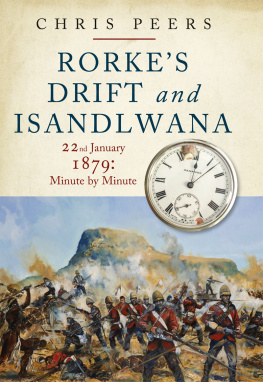Pagebreaks of the print version

RORKES DRIFT
and
ISANDLWANA
RORKES DRIFT
and
ISANDLWANA
22nd January 1879: MINUTE BY MINUTE
Chris Peers
Greenhill Books
Rorkes Drift and Isandlwana
First published in 2021 by
Greenhill Books,
c/o Pen & Sword Books Ltd,
47 Church Street, Barnsley,
S. Yorkshire, S70 2AS
www.greenhillbooks.com
ISBN: 978-1-78438-534-7
ePUB ISBN: 978-1-78438-535-4
Mobi ISBN: 978-1-78438-536-1
All rights reserved.
Chris Peers, 2021
The right of Chris Peers to be identified as author of this work has been asserted in accordance with Section 77 of the Copyrights Designs and Patents Act 1988.
CIP data records for this title are available from the British Library
Maps
The amaZulu and their Neighbours, 1879
The Isandlwana Area: Opening Moves
The Isandlwana Area: Chelmsford Divides his Forces
Isandlwana: The Trap Closes
Isandlwana: The Last Stand
The Isandlwana Area: The Zulus Advance on Rorkes Drift
Rorkes Drift: The Battle Begins
Rorkes Drift: The British Second Position
Illustrations
Colour Plates
The memorial to the dead of the 24th Foot at Isandlwana.
The Mzinyathi River, looking upstream from Rorkes Drift.
The distinctive peak of Isandlwana.
The Isandlwana battlefield from near the modern mission station.
Looking south from the edge of the Nqutu Plateau towards Isandlwana Hill and the valley of the Mzinyathi beyond.
The hill of Amatutshane.
The plain and the Nyogane donga seen from the vicinity of the camp.
The group of memorial cairns south-east of Isandlwana Hill.
South African and British flags fly in memory of the men of both sides who fought and died at Isandlwana.
The Fugitives Trail leading down to Sothondoses Drift.
Typical hillside vegetation on the north slope of Shiyane Hill.
The view from the top of Shiyane Hill towards Isandlwana.
The same view at approximately thirty times magnification.
The rocky ridge on the slope of Shiyane Hill.
The Rorkes Drift mission station seen from Shiyane Hill.
The site of the museum/hospital at Rorkes Drift, from the north-west.
This surviving section of the rocky step which ran along the north side of the perimeter at Rorkes Drift.
The memorial to the British defenders at Rorkes Drift.
Illustrations in Text
The Batshe Valley seen from the Isandlwana road.
The view east from the Tahelane Spur.
The edge of the Nqutu Plateau seen from near the camp location.
Looking towards the Tahelane Spur and Rorkes Drift.
Looking north from near the location of the British firing line.
Looking north from between Isandlwana and Mahlabamkhosi.
The view south-east down the valley of the Mzinyathi River.
The nek beneath Isandlwana Hill.
The Mzinyathi River at Sothondoses Drift.
A cairn of stones remembering a Zulu unknown soldier.
The memorial to Lieutenants Melvill and Coghill.
The upper slopes of Isandlwana looking from the south-east.
Looking towards the Biggarsberg from between Rorkes Drift and Fugitives Drift.
Looking upstream along the Mzinyathi valley.
Shiyane Hill.
Caves in the ledge on Shiyane Hill.
The church at Rorkes Drift, the storehouse in 1879.
Looking down on Rorkes Drift from Shiyane.
The hospital from the north, with Shiyane in the background.
Position of the biscuit-box barricade.
The yard and the hospital.
The remains of the north wall in front of the storehouse.
The position of the mealie-bag redoubt.
The cattle kraal at the eastern end of the defences.
Looking across the Helpmekaar road near Rorkes Drift.
Looking north-west from the upper slopes of Shiyane.
The memorial to the Zulu dead at Isandlwana.
A buffalo thorn memorial tree at Isandlwana.
The well-tended grave of Lieutenants Melvill and Coghill.
The latest memorial to the Zulus at Rorkes Drift.
(All photographs Chris Peers.)
Acknowledgements
I would especially like to thank the following:
Michael Leventhal at Greenhill Books for his encouragement and patience while this book was struggling towards completion under rather difficult circumstances.
Professor John Laband for his extremely helpful advice and comments.
Paul and Christine Lamberth and the staff at Rorkes Drift Lodge, my hosts during my visit in 2015, for their unstinting help and hospitality.
Ray Boyles, who has put me in touch with numerous sources and contacts I might otherwise have missed.
And of course my family, Kate, Megan and John.
Chris Peers
Introduction
Nearly a century and a half ago, in what was then an out of the way corner of southern Africa, a column of British troops set out to invade a local kingdom and put its ruler in his place. There was nothing particularly unusual in this; King Tewodros of Ethiopia in 1868, and six years later the Asante of West Africa, were only the most prominent among those who had already fallen to the superior military technology which the British armies could deploy. In the popular mind a contest between Africans and Europeans came down to a question of spears versus breech-loading rifles and artillery, and the outcome was entirely predictable. Yet, a few weeks after this invasion, on 1 March 1879, a cartoon appeared in the London satirical magazine Punch , entitled A Lesson. It showed a chastened John Bull, representing Great Britain, sitting on a stool and watching an African warrior a Zulu in his full regalia writing on a blackboard the words Despise not your enemy.
On 11 February, exactly a month after the troops had crossed the border, a telegram had arrived in London from their commanding officer, Lord Chelmsford, beginning with the words I regret to have to report a very disastrous engagement, and ending with a plea for urgent reinforcements. It is not surprising that both have earned their place among the most famous deeds in military history, and the details have been argued over and dissected in the minutest detail ever since. It is to be hoped, nevertheless, that the approach adopted here still has something new to offer. Rather than recounting the battles at Isandlwana and Rorkes Drift as two separate stories, or following the adventures of individual participants in turn, the events of this momentous day will be treated as a single minute-by-minute narrative.


















